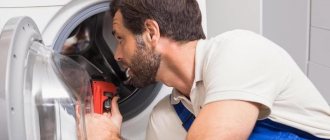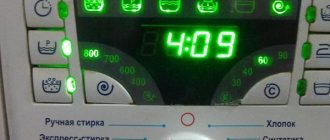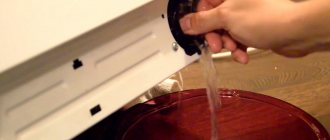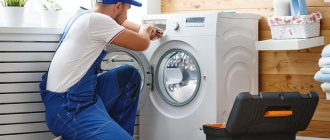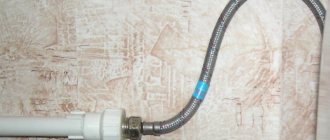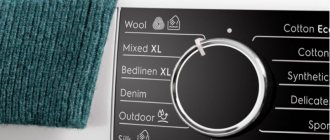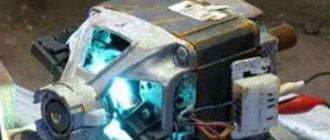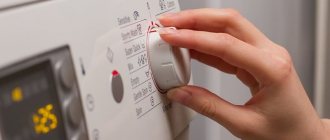The most common causes of extraneous noise
There is nothing particularly complicated in the design of a washing machine. Therefore, there are not so many places where a malfunction can nest. It all depends on at what stage of washing the unusual noise and rattling occurs. The reasons why a loud noise is heard may be as follows:
- The bearing installed in the drum drive has become unusable.
- The mounting bolts holding the tank in place during transportation were not removed.
- The drive pulley is loose.
- The counterweights holding the drum are loose or crumbled.
- Some small objects got between the drum and the wall of the tank and got stuck there.
- The drain pump is broken.
- The rubber seal located on the hatch cover has crumbled or does not fit properly.
- The washing machine is not installed level.
See also -
Why does powder remain in the washing machine tray after washing?
Bearings are damaged
This is a fairly complex breakdown that will require some skill to fix. But it’s not difficult to find it. You need to disconnect the washing machine from the network and spin the drum, pressing lightly on it. First twist clockwise, then counterclockwise. If the movement is intermittent, you hear a whistle, knocking and grinding noise - you can rest assured that the problem is in the bearings.
There is another way to detect the problem. The fact is that a leaky seal leads to bearing damage. When it is damaged, water gets in further and the bearing rusts and crumbles. You can see this by unscrewing the back panel. With such a malfunction, rusty streaks usually appear in the middle part of the tank.
If the cause is found, it must be corrected as quickly as possible.
Operating a washing machine with crushed bearings ends in damage to the bushing and shaft on which the drum sits. All this only aggravates the problem and increases the cost of repairs. See also:
A bra wire got into the washing machine
Why does the washing machine hum or whistle when washing?
Even in good condition, an automatic washing machine makes some noise and whistling, especially during intensive use, and this is completely normal. But there are times when the washing machine hums and rattles so much that it becomes annoying. In this situation, there may be a serious malfunction. In any case, this is a reason to think seriously and start looking for the cause of the unpleasant sound. We will talk about the causes of these sounds made by a washing machine, as well as ways to eliminate them, in this article.
Main causes of malfunction
Why does the washing machine spark, crackle, rattle and make a bunch of other different sounds that it is not supposed to produce? There can be quite a few reasons, and it is not always necessary to first of all pay attention to the moving elements of the washing machine, but first things first. Specialists with extensive experience in repairing automatic washing machines identify several of the most likely and common causes of the hum and whistle emitted by the “home assistant”; let’s look at them.
- Defective cuff of the washing machine hatch.
- The sound is caused by a foreign object getting into the washing machine and touching its moving elements during operation.
- The sound is caused by a defect in the moving elements of the washing machine (pulley, bearings, belt).
- The sound is caused by loosely dangling counterweights.
Note! When troubleshooting, move from simple to complex. There is no need to immediately rush to disassemble the tank and repair the bearings; first check the elements that are easier to reach; perhaps they are the cause of the unpleasant sound.
Hatch cuff defect
This reason may seem strange to some, like how could the cuff be due to the fact that the washing machine whistles and makes a grinding noise? In fact, the connection is direct! The cuff is a large rubber seal that is located around the hatch of the washing machine. Its task is to ensure that water from the tank does not spill out of the machine through the hatch. Under normal conditions, there is a small gap between the cuff and the edges of the rotating drum of the washing machine, and they do not touch each other, but it also happens differently.
In cheap models of washing machines, the cuff may be installed haphazardly or not fit well at all. The edges of the cuff fit right into the drum, catching its edges, or worse, the cuff doesn’t really fit into the groove, which makes it difficult to close the hatch. In this case, if the machine is new, it is better to send it to a service center for repair under warranty. If this is not possible, then you can try to correct the situation yourself.
If the edges of the cuff catch the edges of the drum, then you can proceed as follows.
- Open the hatch cover and inspect the cuff more closely.
- Rotate the drum by hand to the right and left and see which part of the cuff catches the edge of the drum.
- If the clinging edge is small, insert fine sandpaper into the gap between the desired edge of the cuff and run the machine in spin mode. The rapidly rotating drum will erase the protruding part of the gum, and the cause will be eliminated.
- If the clinging edge of the cuff is more than 0.5 cm thick, then removing it is dangerous; it is better to replace the cuff with a new, more suitable one.
Transport bolts
For more careful transportation, special fastening bolts are provided in the washing machine body. They fix the shock-absorbing springs and prevent the tank from dangling from side to side. If the fasteners are not removed after installing the unit, the drum will rotate with a loud knock. What to do?
The problem can be solved very simply. You just need to unscrew the mounting bolts. The noise will stop. They are located in the back wall of the machine. By the way, this is written in great detail in each installation and operating instructions.
Why does the washing machine squeak?
Has your washing machine started squeaking? A sound that is heard as a squeak or something similar to a whistle may appear without any clear reason. That is, the machine worked and worked. All was good. And suddenly it creaked. That happens. There are also other reasons. For example, it may begin to make such sounds after the bearings have been changed. Or if the machine has worked for many years.
Such problems can occur both in all washing modes and in individual parts of the cycle. For example, during spinning, rinsing, main wash.
What could be causing the squeaking?
Let's look at all the reasons:
- Firstly, it may appear if the tank comes into contact with the side parts of the machine body. Such contact during washing can cause such sounds.
- Secondly, small items may get caught under the drum during the washing process. In this case, the creaking occurs from the friction of the item against the tank and drum of the machine.
- Thirdly, there are cases when wool, hairs and other particles of the washable material remain on the cuff of the hatch.
- Fourthly, there is a possibility that the drive belt has become loose. And the sound you hear may be caused by this belt slipping.
- Fifthly, the shaft fastening could weaken.
- Sixth, this sound can occur at the fixation points of the springs that hold the tank.
- And finally, seventhly, these unpleasant sounds can be created by the rubbing butt parts of the machine body.
Washing machine repair
Before starting any repairs, you must unplug the equipment from the outlet. So that we don't get electrocuted in the process. It is also necessary to stop the water supply by turning off the tap.
Retaining springs
Springs that fix the position of the tank can also cause a similar problem. Or rather, the creaking itself will create traction. They may rub against the mounting sockets during washing. How do you know if this is the main cause of the unpleasant sound? In order to check this option, you need to remove the upper part of the washing machine body. And during operation (just when it creaks), press on the seat. If the creaking disappears while pressing, then we have identified a malfunction. In order to remove it, it is necessary to lubricate the contact points between the spring rods and the mounting sockets.
You can use regular machine oil as a lubricant.
Stretched belt
When using the machine for a long time, the drive belt may stretch or wear out. With such a malfunction, the belt can spin, creating such an unpleasant sound in the process. In order to correct the situation, it is necessary to change the belt tension. That is, increase it. Or replace the worn belt with a new one. Below you can watch a video on replacing the belt:
Things got caught between the tank and the drum
As already mentioned above, small items can get caught under the drum of the washing machine when washing. Such things, being pressed between the tub and the drum, can make unpleasant sounds during washing. In order to remove foreign objects from this place, it is necessary to remove the heating element. He's TEN. And through the hole where this element was previously located, we take out and remove the thing.
Shaft
If the machine is used for a long time, the drum shaft may become loose. As a result, backlash occurs. And the shaft begins to creak when it comes into contact with the internal parts. In this case, we can easily fix the damage by tightening the fixing elements.
Contact of the washing machine tank with the walls
If during operation of your machine the tank comes into contact with the walls of the housing, this can also cause squeaking. In order to make sure that this is the problem, you need to check the fixation of the tank, springs and shock absorbers. If you notice any malfunction, fix it.
Cleaning the cuff
In some cases, small particles of laundry may fall onto the cuff of the washing machine door and remain there. Therefore, it is necessary to regularly check the cleanliness of the cuff and remove any such deposits. When cleaning, pay attention to the gaps. If the cuff is contaminated in this way, noise may occur from the contact of the debris and the rotating drum.
Frame
The washing machine body consists of several parts. They are usually connected using screws or other fastening elements. With prolonged use or poor-quality connections, friction may occur between individual parts of the housing. And friction, in turn, can cause squeaking. As you may have guessed, in order to solve this problem you just need to fix the parts of the body more tightly. That is, tighten the screws. In some cases, fasteners will also need to be replaced.
We hope that these instructions will help you with your repair!
Source: https://mashmaster.ru/pochemu-stiralnaya-mashina-skripit-chinim-sami/
The pulley is loose
When the washing machine hums, makes noise and clicks loudly when the drum rotates, the problem may be that the drive pulley is weakening.
This is easy to check. Turn on the machine in test mode. If this is not the case, a hand wash mode or any other mode in which the drum rotates slowly will do. Listen carefully to the sound while looking at the drum. If every time you turn it you hear an extraneous noise, or rather a clicking sound, the pulley is most likely to blame. It's easy to fix the situation. Remove the back panel and locate the mounting nut that holds the pulley in position. Using a wrench of the appropriate size, eliminate the play by tightening the nut until it stops. If the noise during rotation disappears, then you did everything right. If not, we continue searching.
Counterweight is poorly secured
Also, when spinning, the washing machine makes a lot of noise and rattles due to problems with the counterweight. The part is necessary to make the tank heavier, reduce vibration and provide stability. Counterweights are made of cast iron, plastic or concrete, and the latter break and crumble more quickly.
The most common problem with counterweights is poor fit. Over time, the washing machine, operating at high speeds, weakens the fastening. At the same time, the counterweight begins to vibrate and rattle during the spin cycle.
To solve the problem, simply remove the back panel of the machine and check the tightness of the mounting bolts. As a rule, this helps. If it is visually discovered that the counterweight is damaged, it needs to be replaced.
Counterweights
These rather heavy elements of the washing machine hold the unit's tank in place during the spin cycle. They are designed to dampen centrifugal force and counteract the rocking of the washing machine. If you hear a loud noise or rather a rattling noise when spinning the drum, check the counterweights. They are made of concrete, and it tends to deteriorate from old age.
Unscrew the back panel of the washing machine and carefully inspect the counterweights, shake them.
If the fasteners are loose, they need to be tightened by tightening the corresponding bolts tightly. If you find cracks on any of the counterweights, it is better to replace it completely. If this is not done, strong vibration may cause the counterweight to crack and damage the insides of the unit. Then you will have to repair a lot more. See also -
Shock absorbers for washing machines: do-it-yourself repair and replacement
The washing machine is making a loud noise
The occurrence of strong noise during operation of the washing machine rightfully worries its owner - after all, if the mechanisms are subject to excessive vibration, or knocking, grinding, humming, or squeaking is heard, then further operation of the equipment can lead to its failure.
To eliminate unpleasant noise, you need to determine in what mode the washing machine makes the loudest noise and find out why this happens. The nature of the sound is very important - even without disassembling the machine, by listening to its operation, you can determine the cause of the noise.
Why is the new washing machine trying to take off?
Very often, an unnatural hum and vibration can be heard even when you first start a new, just purchased washing machine, which literally jumps in place and even moves to the side, especially at high drum speeds. The reason for this phenomenon is the fastening transport bolts , which the owners forgot to unscrew, as required by the instructions.
Transport fastening bolts and a wrench for removing them
The purpose of these bolts is to rigidly fasten the suspended drum to the body of the washing machine so that during transportation it does not swing or hit the surfaces of internal structures. In operating condition, the center of gravity of the items loaded for washing will constantly and chaotically shift inside the drum.
To compensate for the displacement of the gravity of the rotating drum, its body (tank) is made movable, suspended on springs, and weighted with the help of heavy counterweights. Thus, in the washing machine, the tank with the drum is allowed to perform circular oscillatory movements, and the amplitude of the oscillations is directly proportional to the imbalance.
The tub with the drum is suspended on springs inside the washing machine
Tightened mounting bolts will transmit these vibrations to the body of the washing machine, and this will cause it to bounce. But sometimes this phenomenon also happens when the instructions regarding the mounting bolts are followed. In this case, there is a large imbalance of gravity - perhaps too much laundry is loaded, or it is bunched up in one part of the drum.
The red outline outlines the upper edges of the counterweight
If such a vibration, interspersed with dull knocks, is felt during a small load, then the counterweights may have become loose and they are wobbling up and down on loose bolts. This problem should be corrected immediately so that the counterweights are not damaged, which, as a rule, are made of special concrete, although strong, but not designed to withstand frequent impacts. A broken piece of the counterweight will cause a greater amplitude of vibration in the tank, which will increase the vibration.
Cracked counterweight due to loose fastening
Why does a working car hum and vibrate?
It is very important to ensure that the washing machine is level with the ground before starting it for the first time. If the body stands crooked, the tank on the suspension will move to the side, and there will be a risk of hitting the internal surfaces when the drum rotates quickly.
In the wrong position, the washing machine will constantly move to the side during operation. On a flat and smooth floor, there is a risk that a running washing machine, without encountering any obstacles, will tear out the drain hose from the sewer pipe and flood the entire room with water.
Checking the position of the washing machine using a building level
The position is adjusted using adjustable stands at the corners of the washing machine body, and checking is carried out with a building level. In addition to the absence of tilting, even distribution of weight on all four supports is also very important for quiet operation of the washing machine.
Adjustable washing machine stand
Even a small gap between the rack and the floor will contribute to the occurrence of resonant vibrations of the washing machine body. Often such fluctuations occur during spinning, at maximum drum speed. Having entered into resonance, the body of the washing machine will wobble greatly, while emitting a powerful hum in various ranges due to the deformation of the metal casing.
Clogged internal elements of the washing machine
If the washing machine hums loudly and evenly when draining, but does not pump out water for a long time, it means that of the pump is clogged There may be dirt, fur, hair and even hard objects - buttons and coins. The sump pump filter should be cleaned regularly as a preventative measure.
Severely clogged sump pump
To do this, open the decorative cover at the bottom of the washing machine. There should be a pipe with a plug to drain water from the pump. Substituting a small container in the form of a plate, drain the water and then, with some force, unscrew the filter, remove it and clean it.
External washing machine filter elements
It is necessary to separately describe an almost textbook case encountered by many washing machine repairmen - this is when an arcuate steel wire, a structural part of some bras, gets into the pump. Owners of such linen should wash small items in special bags, or even refuse to machine wash these items.
Supporting knitting needles (wires) of bras can cause damage to the washing machine
Foreign objects inside the drum
Random, chaotic tapping is heard, with a metallic sound. It appears in all operating modes of the washing machine, becoming more frequent during spinning (highest drum speeds). Possible causes are a foreign object getting into the drum. These could be coins, buttons, keychains, etc.
You need to switch the washing machine to drain, remove the water, open the door and remove these items from the drum before they get through the seal into the internal, inaccessible space of the tank body - in this case it will be much more difficult to get them out of there. A mandatory requirement of the instructions is to remove small items from your pockets.
Coins that got into the pump caused the pump impeller to break.
You need to be especially careful when washing workwear - there may be nails, screws, metal wires, etc. in its pockets. Due to their small diameter, they can penetrate into the interior through holes in the drum.
In addition to getting into the sump pump, sharp objects can damage the drum tank housing, heating element, and washing machine hoses.
The heating element is broken due to a steel knitting needle from a bra that went through one of the holes in the drum
Removing foreign objects from hard-to-reach places
If there are no foreign objects in the drum (let’s say towels are being washed in a washing machine - buttons are excluded), and chaotic metallic sounds appear from time to time, then small objects have already entered the space between the drum and the tank body. Sometimes sounds may disappear - this means that objects are stuck somewhere in the cavities of the case.
You should not calm down in this case - due to the vibration and flow of water, these objects can be drawn back into the whirlpool. If the circumstances are unfortunate, a metal object caught between the tank body and the drum can damage both surfaces at high speeds. In this case, the tank housing may leak, thereby damaging the washing machine motor.
Crack in the washing machine tank housing
To prevent this from happening, you should unscrew the back cover of the washing machine and open access to the installation site of the heating element. Having removed the heating element from the socket, you can remove the interfering objects using tweezers or a long hook. The entire process of dismantling and reinstalling the heating element is described in the previous article.
Often, after removing the heating element, users really don’t like what they see inside - large accumulations of dirt and scale, so they decide to completely disassemble the tank body and dismantle the drum in order to clean previously inaccessible surfaces.
Garbage and foreign objects
If you hear an unusual ringing, noise or grinding sound during washing or spinning, the reason may be that some foreign object has entered the tank. This often happens when housewives do not check their pockets very carefully. Such items can be nuts, coins, paper clips, bra underwires, metal buttons, and so on. What to do? How to eliminate extraneous noise?
We'll have to tinker. In order to look into the tank, you need to get to the heating element and unscrew it. Through the resulting hole, using long tweezers or just your fingers (if possible), remove objects that make an extraneous sound. Now you need to put the heating element in place, not forgetting to clean and degrease the rubber seal. It can be lubricated, for example, with liquid detergent.
Sometimes the problem can be solved much easier. Some models of “washing machines” have a special sump in which a filter is installed. In this case, you just need to open the sump door. It is most often located in the front. Now we just take out the filter and shake out everything that gets into it.
Why does the washing machine hum and whistle when washing?
The washing machine is not silent during operation, but makes sounds - during washing, during rinsing or during the spin program.
But sometimes the car starts to rattle, hum, whistle and make noise very loudly, which does not have a positive effect on the human nervous system.
How to determine which noise is normal and which is not?
It all depends on the drive.
Why does the washing machine hum or whistle when washing?
In the belt drive version of the machine, it is normally considered to be from 60 to 72 dB, and if it is a direct drive, then from 52-70 dB. Otherwise, the sounds may indicate a malfunction of the machine.
Such a nuisance can occur when starting the machine for the first time. In this case, you can check the transportation bolts; maybe they were simply forgotten and not removed. Or perhaps the equipment is installed incorrectly and needs adjustment.
In other cases, there can be many reasons for failure. Let's look at the main points at which a car can make strange sounds.
Pulley
A common situation for old automatic machines. If the washing machine begins to hum or makes sounds similar to clicks, then most likely the pulley has become loose.
Belt
To get to the belt and pulley in order to check their performance, you need to:
- Remove the back cover, under which there is a large wheel - this is the pulley.
- Inspect the pulley for defects. If they are missing, move on.
- The drive belt is mounted on a pulley and requires careful examination for defects, because even a slight crack affects its operation.
Counterweight
If the belt is in working condition, then you need to get to the counterweight.
To do this, you must first find a counterweight. It looks like a big rock bolted to a car. If the mounting holes are larger than the bolts screwed into them, the counterweight must be replaced. To be 100 percent sure of the replacement, try rocking the counterweight from side to side. If it wobbles, it definitely needs to be replaced.
Bearing
An unsuccessful failure is a bearing failure. Why? Because it is very difficult to replace it yourself, but it is possible.
- You will need to remove the heating element and pull out the engine by moving the belt.
- Next comes the tank, which needs to be halved.
- All that remains is to knock out the bearings and replace them with new ones.
Typically, the seals that seal the tank are the first to wear out. In this case, moisture enters the bearing and it rusts and breaks.
Problem with the hatch cuff
The washing machine whistles or makes a loud noise during the spin cycle and it’s not clear what the cuff has to do with it?
But in fact, if the cuff is installed poorly, it may not fit into the groove of the machine, which prevents the hatch from closing tightly.
Or the cuff may hang down or even be installed “haphazardly”. If the cuff clings to the edge, the following steps will help fix it:
- Inspect the cuff.
- Find the clinging edge.
- To correct a small edge of up to 0.5 cm, you will need fine sandpaper (not a knife), which is inserted into the gap between this edge.
- The next step is to turn on the spin mode. The point is that the drum, rotating, will erase the protruding part, and the machine will stop making noise. If the edge is larger, then the best solution is to replace the cuff.
Foreign objects
The culprits of the malfunction are not always the moving elements of the machine.
The washing machine sometimes whistles when the drum rotates due to the presence of foreign objects.
These could be paper clips, pins, coins, nails, underwear bones, etc. These cute and small-sized items are quite capable of sending your car to the landfill.
If there is a foreign object between the drum and the cuff, it can be removed.
Faulty pump
Sometimes, when the washer hums and makes noise while draining water, the reason may be that the drain pump is damaged. You can try to correct the situation by cleaning the strainer. It is located on the front side of the unit, behind a special cover.
You also need to make sure that the drain pipe is clean. This is another reason why the machine began to make noise. Clean the pipe, it is likely that the noise will disappear.
If nothing helps and the unit still hums and rattles, things are bad. The drain pump has completely failed and will have to be replaced. To avoid mistakes, listen carefully to the operation of the unit. You can “suspect” the pump only if the “washing machine” makes noise only when filling or draining water, and the rest of the time it works quietly. The sound will be very similar to the noise of a running transformer.
Why does the washing machine whistle when washing - Construction, repair, arrangement
Even in good condition, an automatic washing machine makes some noise and whistling, especially during intensive use, and this is completely normal. But there are times when the washing machine hums and rattles so much that it becomes annoying.
In this situation, there may be a serious malfunction. In any case, this is a reason to think seriously and start looking for the cause of the unpleasant sound.
We will talk about the causes of these sounds made by a washing machine, as well as ways to eliminate them, in this article.
Why is the washing machine so noisy?
Modern washing machines are distinguished not only by excellent quality of washing things, but also by such a pleasant “bonus” as low noise level during operation.
And this is really very important: you can start doing laundry at any time, even at night. Unfortunately, in some cases, washing machines begin to make noise. Sometimes due to breakdowns, sometimes due to not entirely correct operation.
Most often, owners contact the service center with complaints about the following noises:
- The washing machine makes a lot of noise when spinning, vibrates or even “jumps,” thereby creating additional noise.
- When draining water from the machine, the drain pump makes loud noises.
- The machine makes noise whenever the drum rotates: during washing, rinsing, spinning, and even if you simply turn the drum by hand.
- A loud noise is heard when drawing water.
Does this always indicate a breakdown? Let's figure it out.
Equipment may make sounds - this is normal.
It is worth understanding that a washing machine, like any unit, still creates some sounds during operation. In particular, you may hear:
- the sound of water pouring as it is drawn;
- the noise of a running drain pump (pump) when draining water;
- the sound of the engine when the drum rotates;
- drum noise at high speeds during spinning;
- clicks if the machine switches modes, for example, moves from the washing phase to rinsing mode, etc.;
- the noise of water heating, like in a kettle, during the washing process.
Source: https://gildiyamebel.com/pochemu-svistit-stiralnaya-mashina-pri-stirke/
Rubber compressor
It happens that during operation, and especially during spinning, the washing machine whistles.
In this case, you find rubber shavings on the cover or walls of the hatch. Most likely it's the seal. This most often happens with inexpensive models of washing machines. Of course, it is best to replace the seal and choose a new one that fits in size. But you can try to solve the problem with the help of advice from folk craftsmen. Take a small piece of sandpaper and insert it between the front wall and the rubber seal. Now run any wash cycle that is at least half an hour long. There is no need to put laundry down. Sandpaper will help you adjust the elastic to size. All you have to do is take it out and remove the rubber debris from the machine. To do this, run an additional rinse cycle and then clean all filters.
Incorrect installation of the washing machine
Sometimes the answer to the question why a home laundry machine rattles and rattles during washing, especially during the spin cycle, is that it is simply not installed correctly. We are not talking about the electrical part here, but simply about its physical location. If the unit is not installed level, then when rotating at high speeds, for example, during a spin cycle, the centrifugal force will unbalance it. This leads to the following consequences:
- strong vibration is observed;
- the body of the car sways or “jumps”, moving from its place;
- A strong knocking and beating of the drum is heard.
To correct the situation, nothing needs to be repaired. All you need to do is set the washing machine level by tightening the legs. The sound should disappear.
If, after checking all the reasons described above, you still have not found the reason why the washing machine makes unusual sounds, the problem may be in the electric motor or the “wired” part of the unit. You can’t do this without special skills. It's best to call a professional. Using a multimeter, he will carefully “ring” all suspicious places and determine the cause of the hazing sounds.
Eliminating the causes of noise during operation
Depending on what factors led to the hum, whistle and other sounds during the spin cycle, certain actions should be taken. In addition to the reasons that are characteristic of all ACM models, there are those that depend on the design features of individual brands of machines: LG, Ariston, Electrolux and other brands.
Transport bolts
One of the most common situations that can lead to serious damage to the machine. Often, craftsmen installing a new SM, in a hurry, forget to remove the bolts designed to secure the drum during transportation.
Before installing the washing machine, you need to unscrew the transport bolts
If the washing machine makes strange sounds when spinning during the first wash, knocking and other specific sounds are heard, you should immediately check whether the bolts have been removed from the body.
Foreign object in tank
Very often, when loading laundry into the drum, owners do not check the contents of their pockets. And there may be coins, pins and other small objects that can fall from the drum into the tank.
Seal lip with a foreign object stuck in it
When the drum shakes and rotates at low speed during washing, small objects do not make themselves felt. As soon as the spin cycle begins and the vibration increases, objects begin to move, falling into the gap between the tank and the drum. As a result, the washing machine rattles during the spin cycle, whistles, hisses and rumbles.
Location of the heating element in the washing machine
You can solve this problem yourself. To remove a foreign object, turn off the power to the AFM, remove the back cover and release the heating element by removing the fasteners. Its most common location is under the tank, near the electric motor. After this, carefully remove the foreign object from the resulting niche using your fingers or a handy tool, for example, long pliers or a medical clamp.
This video describes how to remove foreign objects from the tank:
Bearings are worn out
In most cases, the drum rotates inside the washing machine tub on two bearings. These parts are subject to wear, especially due to vibration caused by the large amount of laundry in the drum. Another reason for their destruction is the ingress of water and detergents through a leaky oil seal.
Worn drum bearing with water ingress
If the washing machine hums during the spin cycle, it is worth checking the condition of the drum ball bearings. To do this, you need to turn off the power to the SM, open the hatch, put your hand into the drum and turn it in one direction, and then in the other. If the bearings are in good condition, a slight rustling noise will be heard when rotating. A cracking, knocking or slight hum will indicate damage to parts.
Replacing bearings and oil seals is a difficult and troublesome task. We'll have to disassemble the AFM completely. If the tank is plastic and cannot be disassembled, you will need to completely replace the expensive unit. True, there are craftsmen who cut the tank and replace parts themselves. Then the tank is glued together and the SM is successfully used further. But if you do not have the experience and necessary skills in handling tools, it is better to entrust the replacement to a qualified craftsman.
This video provides information on how to replace bearings in a non-separable plastic tank ASM Ariston:
Loose pulley or belt
If the washing machine makes noise during the spin cycle and clicks are heard, you should pay attention to the drum pulley and drive belt. As a rule, such a defect appears after prolonged use. During this time, the belt can stretch, shift and slip in the pulley. If the pulley mounting nut is loose, it can rotate relative to the drum.
Washing machine drive belt and drum pulley
You can diagnose such malfunctions by running a test mode or hand wash (the drum should rotate slowly). If extraneous sounds do not disappear, you should remove the back cover and inspect the parts. First of all, tighten the pulley mounting nut - it is quite possible that it has become loose. For more reliable fixation, you can apply sealant to the nut. Check the belt tension and adjust it if necessary. If after these steps the noise level does not return to normal, replace the belt.
Counterweights are shifted
The tank is attached to the SM body with springs to minimize vibrations during spinning. For the same purpose, counterweights located around the tank are used. In most ACM models they are attached to the tank with screws.
Top counterweight with mounting screws
Under heavy loads and after prolonged use, the fastenings of the counterweights may become loose. In this case, the parts change position, shifting the center of gravity of the tank. As a result, the washing machine makes noise when spinning, and also vibrates strongly, rumbles and even bounces. This problem can be eliminated by tightening the fastening nuts or screws securing the concrete blocks until they stop. In order to get to the counterweights, you will have to remove the top and back covers.
Incorrect installation
Carelessness when placing and leveling the SM on the floor can lead to its imbalance during operation. If the unit is not installed level and all legs do not rest properly on the floor surface, during spinning there will be a rumble, rattling and displacement of the ASM relative to its place.
When installing, the washing machine must be level
It’s easy to check that the installation is correct: just place a level on the top cover. If it is misaligned, you will have to level the machine by adjusting the height of the legs.
As you can see, you can independently eliminate the reasons that the washing machine is noisy during the spin cycle. The only exception is bearing wear. But if you have plumbing skills and experience in handling tools, such a problem can also be fixed on your own.
Prevention
In order to invite a technician into your home as little as possible, it is enough to follow simple rules for operating the washing unit. This will not only extend its service life, but also save you from unnecessary hassle. What are these rules?
- Do not overload the machine. It is better to put a little less laundry in it than required according to the instructions.
- Try to do laundry no more than once a day. This will avoid additional stress on the parts. The washing machine will have time to cool down and dry thoroughly.
- Clean all possible filters regularly. You can also install additional water purifiers if necessary.
- Clean your machine from limescale deposits more often. Use special tools for this and follow the instructions.
- If possible, run the boiling program and spin mode at maximum speed as often as possible. If you do this often, components and parts will fail much faster.
- Before putting things in the machine, do not forget to carefully inspect the pockets and folds. Keep buttons and zippers fastened, and use a special bag for washing bras. All these precautions will save you from “fishing out” small objects from the bottom of the drum.
And remember: you shouldn’t delay the repair of the “home laundry”. If you ignore the problem at the initial stage, the matter may worsen and then the repair will cost much more.
See also:
- 10 Best Top Loading Washing Machines
- 10 best Hotpoint-Ariston washing machines according to customer reviews
- 10 best Electrolux washing machines according to customer reviews
- 10 best ATLANT washing machines according to customer reviews
- 10 best built-in washing machines
Bearings
One of the most common reasons why a washing machine is noisy during the spin cycle is problems with the bearings. The only element that protects them from water and air is a rubber seal. It is not surprising that over time, leaks occur on the part, and as a result of corrosion, the washing machine begins to whistle and make unpleasant sounds. Usually the oil seal lasts for 5-7 years of stable operation, after which it needs to be replaced.
To detect bearing failure, you need to manually rotate the tank. If you hear a crackling sound or feel play, it is necessary to urgently lubricate or replace the problem unit.
Important : bearing repair is a very labor-intensive process and requires compliance with all manufacturer’s recommendations. If you are not confident in your abilities, it is better to contact a specialist.
Step-by-step instructions for self-replacement:
- You need to start by removing the top and back covers, after draining the water and relieving the voltage from the device.
- Remove the powder dispenser and then carefully remove the control panel. Most often it is secured with simple latches or a few screws.
- Similar to clearing debris, remove the heating element, and then the pipes and counterweight.
- Dismantle the weights that are located below and above the tank to facilitate removal of the drum.
- Remove the belt from the drum and engine pulleys, and then unhook the part from the shock-absorbing springs.
- Carefully remove the assembly and unscrew the pulley to get to the bearing. This can be done using a hammer and a blunt chisel. It is worth noting that in some models you will have to disassemble the drum.
Important : use only lubricants recommended by the manufacturer.
The replacement process is quite simple. It is necessary to remove old parts from the sockets, and then clean the metal rings from dirt. The next step is to install the new parts in place and apply lubricant. A thin layer is sufficient for the seal, but the bearings must be thoroughly treated.
Assemble both the bearings and the seal correctly. The latter, if installed incorrectly, will begin to let air and moisture through again.

